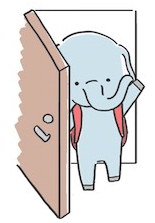オノマトペとは?擬音語や擬態語のことを英語では“onomatopoeia”(オノマトペ)と言います。オノマトペは、音や動作を模倣した言葉や擬音語のことです。日本語にはさまざまなオノマトペが存在します。以下に、代表的なオノマトペをいくつか挙げてみます。
ゴロゴロ:音を表現し、雷が鳴る様子や、大きな物が転がる音
キラキラ:光が輝く様子や、きらめくものの音や姿
ワンワン:犬の鳴き声
むしゃむしゃ:食べ物を噛む音や、何かがむしゃむしゃと動く音
ぴかぴか:物がピカピカと光る音
ぽたぽた:小雨や液体が落ちる音
くるくる:何かがくるくると回転したり動く様子
ぐるぐる:何かがぐるぐると回転する様子
カリカリ:固いものが摩擦する音や、サクサクとしたものの食感
ズボズボ:液体が中に入り込む様子や、もぐもぐと進む様子
カサカサ:乾燥している音や、何かがサラサラと動く様子
ざわざわ:不安や緊張感が漂っている様子、または物がざわざわと動く様子
もろもろ:さまざまなものが散らかっている様子。また、何かがばらばらになる音を表すこともあります。
ビンビン:音が非常に鋭く、強烈な印象を与える様子
つるつる:表面が滑らかでつるつるとした様子
ガブガブ:物を大きくかぶりつく様子や、飲み物を飲む様子
キャーキャー:喜びや興奮、または驚きや恐れなどを表現するときに用いられます。女性や子供が可愛らしい驚きの声を発するイメージがあります。
ザーザー:大雨が激しく降る音
キンキン:鋭い音や、金属が鳴るような高い音。または、非常に冷たいものを意味します。
ほかほか:温かくてぬくもりを感じる様子
ぽかぽか:日差しが心地よく温かい感じ
ばりばり:固いものが割れる音や、力強い様子
これらのオノマトペは、言葉だけでなく感覚や状態を生き生きと表現するために使われます。日本語においては、オノマトペが豊かに用いられ、コミュニケーションや文章などでさまざまな印象を伝える役割を果たしています。
Onomatopoeia (sound symbolism, mimetic words)
What is an onomatopoeia? An onomatopoeia refers to symbolic sounds or mimetic words. It is a word or sound effect that imitates a sound or motion. In the Japanese language, there’s a variety of onomatopoeias. Some typical onomatopoeias are:
Goro-goro: the sound of thunder or a large object rolling
Kira-kira: the sound of sparkling objects and describes light shining on something
Wan-wan: the sound of a dog barking
Musha-musha: the sound of someone chewing food or munching something
Pika-pika: the sound of something shining or glittering
Pota-pota: the sound of light rain or liquid falling
Kuru-kuru: the sound of something spinning in a circle
Guru-guru: the sound of something spinning around
Kari-kari: the sound of scratching a hard object or eating something crunchy
Zubo-zubo: the sound of liquid going or squirming through something
Kasa-kasa: the sound of something dry or the sound of something rustling lightly
Zawa-zawa: the sound of something rustling or the sound of a noisy environment, which gives off the sense of feeling anxious or uneasy
Moro-moro: the sound of something falling apart, giving off the feeling of things being scattered
Bin-bin: a very sharp and intense sound
Tsuru-tsuru: the sound of something smooth like a sleek surface
Gabu-gabu: the sound of someone taking a large bite or drinking something
Kyaa-kyaa: the sound of joy and excitement, or surprise and fear (as a woman or child making a cute surprised sound)
Zaa-zaa: the sound of heavy rain falling
Kin-kin: the sound of something sharp or high-pitched like metal clanging, or something extremely cold
Hoka-hoka: the sound that gives off the feeling of something warm and comforting
Poka-poka: the sound that gives off the feeling of the sun’s pleasant warmth
Bari-bari: the sound of something hard cracking or the feeling of something strong
Japanese people don’t just use these onomatopoeia examples as words, but they also use them to vividly express sensations and conditions. In Japanese, people use onomatopoeias frequently and they play a role in conveying various expressions in communication and writing.

sign up for the Japanese-Online Newsletter
__..-・**・-..__..-・**・-.._ あいうえお かきくけこ さしすせそ たちつてと なにぬねの はひふへほ まみむめも やいゆえよ らりるれろ わゐうゑを ん __..-・**・-..__..-・**・-.._
#JapaneseOnline #LearningJapanese #FreeJapaneseLessons #JapaneseVideoLearning #JapaneseAnime #Anime #JapaneseFood #Bloguru